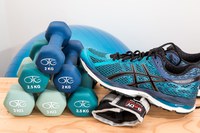Prairie Fare: What should we eat and do as we age?
(Click an image below to view a high-resolution image that can be downloaded)
“I have an old man body now,” the person in the restaurant said. “I keep gaining weight.”
He wasn’t talking to me or my husband. His booming voice carried across the nearly empty restaurant. We heard the saga of his life.
I wasn’t trying to eavesdrop. Really, I wasn’t. I just couldn’t tune out his voice.
The man talked about how easy it was to lose weight in high school. Sometimes he needed to cut weight while in wrestling, and he dropped several pounds easily.
He gained weight in college then easily lost it. He talked about the difficulty of losing weight at his present age. I am guessing he was somewhere in his 50s.
We weren’t eating in a health food restaurant, I will admit.
I looked across the restaurant to see what he was eating. I could see that he wasn’t eating a salad.
I estimated he had a full day’s allotment of calories heaped on his plate. I didn’t fly across the restaurant in my dietitian cape or suggest he have a complete physical with his healthcare provider. I would never do that, but he did inspire this column.
My husband and I both requested to-go boxes after listening to his story.
Unfortunately, we cannot stay eating the same number of calories throughout life and expect to stay the same weight. Changes in weight status with age are quite predictable as we grow older, unless we take some action in our nutrition and fitness.
As we grow older, we need to be aware of our physical activity and nutrition, even more so than in our youth. For most people, metabolism slows down and we need fewer calories and a nutrient-rich diet.
We need to get our heart beating with aerobic activity, such as walking around the neighborhood or playing a fun game such as pickleball.
Adults of all ages need about 150 minutes of moderate-intensity physical activity.
We also tend to lose muscle as we grow older, unless we take some steps to maintain our strength. Muscle-strengthening activities become even more important. Take a class with strength-maintaining exercises.
When your muscles are strong, you can get out of a chair easily, carry in groceries and twist the lids off of containers.
Doing activities such as yoga or standing on one leg helps maintain our balance. This is especially important in reducing our risk of falls.
Nutrition is vitally important in maintaining our health throughout life, but especially as we grow older.
While packaged snack foods may be tempting, some snacks are healthier than others. Making our calories “count” remains important throughout life.
Consider these tips.
- Choose foods with little or no added sugars. Compare nutrition labels. Regular soda is high in added sugars with at least 12 teaspoons of sweetener per 12-ounce can. Reserve those bottled calories for occasional treats.
- Stay hydrated by drinking plenty of water, even when you may not feel thirsty. Our thirst mechanism may not work as well as we age. Drinking low-fat or fat-free milk and 100% fruit or vegetable juice can help with hydration, too. However, choose whole fruits and vegetables more often than juice.
- Choose foods with less sodium and saturated fat to help maintain a heart-healthy diet. Compare the values on the label.
- Get enough protein to maintain muscle mass. Choose a variety of protein-rich foods from plant and animal sources. Protein-rich foods can help maintain our muscles, along with weight-bearing activities.
- Focus on these nutrients of concern: potassium, calcium, vitamin D and dietary fiber. Fruits, vegetables and dairy products are excellent sources of potassium, for example. If you follow a strict vegetarian or vegan diet, you probably need a dietary supplement of vitamin B-12. Work with your healthcare provider to determine your needs.
- Visit the gov website for a free downloadable list of your calorie and nutrition needs. Visit with a registered dietitian for a good assessment of your current diet.
Instead of a recipe, here are some snack ideas that also provide nutrition in every bite. Try to include two or three of the five food groups (grains, vegetable, fruit, dairy and protein) when you choose a snack:
- Hummus (chickpea dip) and whole-wheat pita bread.
- Vegetables, such as carrots or broccoli spears, with low-fat or fat-free ranch dip.
- Mozzarella cheese sticks with whole-grain crackers.
- Baked tortilla chips with black bean and corn salsa.
- Dried fruit, such as dried cranberries, and lightly salted nuts, such as almonds.
- Low-fat yogurt with sliced fresh fruit.
- Popcorn and apple slices.
- For a variety of recipes, see www.ag.ndsu.edu/food and click on “recipes.”
- See www.ag.ndsu.edu/nourish to learn about our “Nourish” program that is offered both online and face-to-face.
(Julie Garden-Robinson, Ph.D., R.D., L.R.D., is a North Dakota State University Extension food and nutrition specialist and professor in the Department of Health, Nutrition and Exercise Sciences.)
NDSU Agriculture Communication – May 23, 2024
Source: Julie Garden-Robinson, 701-231-7187, julie.garden-robinson@ndsu.edu
Editor: Elizabeth Cronin, 701-231-7006, elizabeth.cronin@ndsu.edu




